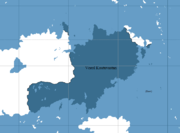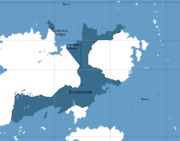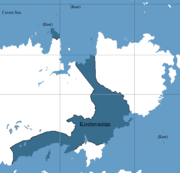Salovia
| The Grand Monarchy of Salovia and Her Territories,
then The Grand Republic of Salovia Salovia
| |||||
|---|---|---|---|---|---|
|
|||||
|
|||||
| Capital | Port Barnaul, later Chita, then Novosibirsk | ||||
| Largest city | Port Barnaul, later Novosibirsk, then Tarov | ||||
| Demonym | Salovian, Salov | ||||
| Government | Absolute monarchy, later democracy | ||||
| Currency | Sinar, later the Salov Credit | ||||
Salovia was a nation that stretched throughout the middle of Aurora, and was separated after its civil war. It bordered the countries Caltharus and Ethalria. The nation was replaced by the nations Tuvaltastan, Tivot, Kostromastan, Nilovia, and Baykalia, and is the successor to the Kostuvian Empire.
Contents
History
The Nobility of Suvol (893 BCE-12 AD)
The Grand Monarchy of Salovia (12-1894)
Salovin Reign (12-396)
Prior to the founding of Salovia, the geographic area was scattered with small kingdoms and citystates. Rorik von Salovinich was born a royal in the citystate Suvol. Upon being appointed as the Noble of Suvol, Salovinich declared himself the first king of a new empire and murdered the king of Suvol, and subsequently renamed The Kingdom of Suvol to The Grand Monarchy of Salovia, named after Rorik von Salovinich himself. Through various raids and marriages, Salovia grew into a nation much larger than its predecessor Suvol. The high class inhabitants of Kristoa, now modern-day Chita, held much of the wealth of the fledgling monarchy, as was typical during that time. Inhabitants of Kristoa were typically appointed by the king to high-ranking positions, with some even being chosen to marry into the Royal bloodline. The infrastructure of the nation was advanced for its time, establishing a network of roads that connected the areas ruled by the Salovian kings, as well as a primitive sewer system in Kristoa. A mailing network had also been set up to connect the highest ranking individuals in the kingdom for better communication. The Salovin Reign was predominantly defined by its struggles and skirmishes with neighboring tribes and kingdoms to maintain its sovereignty, as well as its expansions southwards and eastwards along the Kalivian Mountains.
Loktol Reign (396-827)
The Loktol Reign began upon accession of Jeoffery Salovin, who had secretly had his siblings killed off by a paid assassin. After doing so, Jeoffery declared himself the new King of Salovia, and began a new reign under the new surname Loktolovich. The Loktol Reign continued the expansion of the kingdom, spreading as far south as modern-day Xagrurg and Kostoria-Obertonia. Port Anton, later Shagonar, was established during this reign. The kingdom also began expanding eastwards during this reign, reaching as far east as modern-day Novokuznetsk. Salovian engineers and architects, interested in the idea of connecting the north and south together, began experimenting with excavating tunnels in the Kalivian Mountains.
Other notable monarchs include Tanya Loktolovich, who was the first Queen of Salovia. Her reign, however, was marred by scandal, with the queen having been in at least three unique relationships whilst married. The first queen had only given birth to one legitimate heir to the throne, with another six being born out of adultery. She would later be poisoned by one of her lovers, giving way for her son to become the next king at a young age.
Lewin Reign (827-895)
The Lewin Reign consists of a single monarch, Rorik Lewinski. The son of Queen Tanya, Rorik ascended to the throne at the age of 11. Arguably the most unpopular monarch in Salovian history during his height, Lewinski exploited his kingdom through taxes and became the richest Salov King ever, with a wealth of $830,000,000,000 in today's SHD. This hoarding of wealth and gluttony resulted in the nation suffering a famine the likes of which wouldn't be seen until the Salovian Civil War. The people of Salovia as a result revolted against the king and executed him, along with his three sons, leaving Lewinki's populist daughter the throne. Lewinski was executed at the age of 39, his daughter Beatrice gaining the crown at age 25.
Qurala Reign (895-1214)
(Main article: Qurala Reign)
Beatrice Qurala, although not the first Queen of Salovia, was by far the most influential and successful. Beatrice revoked many of the taxes instated during her father's reign, and grew the economy by establishing trade routes with neigboring Ethalria, Dragonia, Xagrurg, Oceansend, and Staynes. Being reproductively sterile, and with no other family member willing to take the throne for fear of execution, Beatrice adopted a son, Ivan, who became the male genetic root of the rest of the Salovian Royal Family tree. Because Ivan did not have royal blood, he was to marry Xenala I, a monarch from the fledgling kingdom of Nilovia whose bloodline, like the Salov Royal Family, traces back to Rorik Salovinich. This reign continued the growth seen during the Loktol Reign, and oversaw the completion of the first practical tunnel running under the Kalivian Mountains. This tunnel, known as the Horol Tunnel, would provide a significantly faster route from Chita down along the Salovian river towards Port Anton.
Salovian Interregnum (1214-1352)
This era consisted of many incompetent and lame-duck monarchs who, for around a century, neglected the welfare of the monarchy and instead luxuriated in their immense wealth accumulated by King Rorik Lewinski, which led to an eventual collapse of the nation in 1330 upon the succession of King Ivanolov Qurala III. Ivanolov's twin brother Ivanovich Qurala II, in an act of jealousy, declared himself the true King of Salovia. This battle for dominance would split the empire into the northern Rukin reign and the southern Alvonic reign, resulting in the central highlands and desert separating for a time from Salovia, forming an early predecessor to Kostromastan called Volova, and the area around Lake Nilovi gaining independence, forming the first lasting iteration of Nilovia. It took another century and a half to restore relations with the neighboring states, and to reunite the monarchy back together.
Molgov Reign (1352-1786)
(Main Article: Molgov Reign)
The Molgov Reign is the longest-running reign in Salovian history, and it's early years are marked by the reunification of the breakaway nations back into the monarchy. Taking the economic policies of the Qurala Reign, and the industriousness of the Loktol and Slovin dynasties, the Molgov Reign improved every aspect of the Salovian way of life. These centuries of prosperity would eventually lead to the invention of the Auralgraph and the steam engine in later years. During the end of this reign, Codexian settlers began settling in the area east of the empire, which would later evolve into the nation of Xiopothos.
Vorolov Reign (1786-1792)
Similar to the Lewin Reign, the Vorolov Reign only had a single monarch, named Rorin Vorolov. Known as Rorin the Terror, Vorolov's army killed any who opposed his tyrannical rule. Millions were killed, however the exact number is unknown. Estimates range from as little as 2,000,000 to as much as 15,000,000. Regardless, Vorolov and his army attempted to conquer the whole of Aurora, and succeeded in taking most of the territory east of the Morstaybishlian Mountains, with exception to the Codexian colony as well as Ethalria and Xagrurg. The last legitimate monarch of Salovia, Rorin Vorolov had only one son with a mistress, who was named Lurin Vorolov I, who would inherit the riches of his father. After the assassination of Rorin Vorolov, Lurin Vorolov would also attempt to declare himself the next king of Salovia, but the lack of any real legitimacy to the throne resulted in many Salovians to assert the royal bloodline to be at an end.
Era of Unrest (1792-1816)
(Main article: The Era of Unrest)
The Era of Unrest was a tumultuous period wherein the nation of Salovia was without a singular form of government, with many of the major cities resorting to self-governance and rural areas experiencing increased autonomy for a period of time. The old constitution, one that had placed the Salovian Royal Family at the head, was no longer considered to be legitimate, resulting in a slow trend towards anarchy and political separation among the diverse regions of the nation. In 1796, a grassroots organization in Novosibirsk, calling themselves the "Grand Salovian Republic," had begun to garner a limited amount of support throughout the fractured nation. The Grand Salovian Republic's governing system, inspired by the Xagrurgian democratic system and the Codexian colony Xiopothos's democratic system, had established in its constitution three branches: Executive, Legislative, and Judicial. By the turn of the century the group had essentially replaced the original nobility-inspired government that had formed in Novosibirsk, with most of the surrounding rural communities opting to join the newly-created Republic. Around the same time, the area in what is now modern-day Baykalia had gained independence from Salovia. This secession was soon followed by a nationalistic fervor throughout the rest of Salovia, with the local rural and city governments quickly backing the Grand Salovian Republic as the true and legitimate government of the nation, and in 1811 a Unification Ceremony was held in Novosibirsk. Increased tensions between Caltharus and the new Grand Salovian Republic began to sprout, with the primary dividing issue being the newly-independent Baykalia. Both nations claimed Baykalia to be a legitimate part of each other's territory, with the two nearing the brink of war over the disputed claim. The five years after the Unification Ceremony, Baykalia experienced a period of mass poverty and starvation throughout the area, known in Baykalia as the Age of Fatigue. Hundreds died of starvation and disease, and the leader of the fledgling nation struck a deal with the Salovian leader in which Baykalia would be annexed by Salovia, but it would require Baykalia to have more say in the nation's affairs than the rest of Salovia. Another notable series of events during the Era of Unrest was The Codexian Empire's push into Salovian territory, the empire slowly acquiring large chunks of land at a time through various methods, including land purchases such as the Primoria Purchase, the Crusade of the Bandits, a series of bandit attacks taking place on the far desert reaches of Salovia, and a short-lived war between Codex and Salovia over the area just east of modern-day Tuvaltastan, known as the War of the Crescent Coast.
Modern Salovia (1814-1985)
The Era of Unrest came to a close, with the Grand Republic of Salovia being accepted nationally as the new government of the region. The first Chancellor of this new republic was Mikhail Karanovich, who would go down in history as the greatest and most influential leader of Salovia, having kept the diverse peoples and polities of the nation united, succeeding in repairing the infrastructure and economy, and keeping the public's faith in their leadership. During this era, Salovia entered into a short and controversial period of colonialism, invading and conquering the territories of what would become Lapimuhyo in Gondwana and Puntalia in Arcturia. The Grand Republic would continue to exist as the internationally-recognized government until the Auroran Imperial War and the Salovian Civil War split the nation into its modern counterparts Tivot, Baykalia, Kostromastan, and Tuvaltastan in 2005, with Nilovia breaking away from Tuvaltastan in early 2008.
Rise in Colonialism
Tensions with The Morstaybishlian Empire and Alliance with Xagrurg
Auroran Cold War
Governmental Changes in the 1960s
Ideology Shift
Prior to the Auroran Imperial War
Decline of Salovia
Salovian Participation in The Auroran Imperial War
From the beginning to the middle of the 1970's, Salovia was on the Empirical side of The Auroran Imperial War, and spent much of its participation attacking and defending the western and southern borders of the nation. Prior to the conflict, Nilovia had successfully acquired independence shortly before the war, and joined the Allies. By the end of the war, however, Nilovia would be re-absorbed into Salovia for the remainder of its time as a nation.
Salovian Civil War
The Salovian Civil War was by far the most devastating war in Salovian history, and arguably one of the deadliest in world history. Killing around 60 million people through both direct and indirect means, the war resulted from a growing hostility by the polities of Volova, Tuvalia, Altaya, and Kostromia towards the semi-autonomous polity of Baykalia, who gained a disproportionate representation due to the Baykalian Annexation Deal of 1816. Baykalians had held a majority in both the upper and lower houses of legislature since the 1950's, and systematically passed legislature that would slowly maximize Baykalian influence and minimize the influence of other polities in elections and in legislature. Following numerous protests, marches and riots, most notably the 1957 March for Equality, the 1966 Nal'Chik and Shagonar Riots, and the 1976 Protests in Novosibirsk, the polity of Volova, backed by Tuvalia, Altaya and Kostromia, began the civil war by attacking Baykalia in the Battle of Irkutsk, officially starting the war in 1985. It would be another two decades, and numerous battles, airstrikes, and deaths until the war would officially end in 2005 with the signing of the Treaty of Astrakhan.
Economy
Thanks to the diverse geography and relatively large size of the nation for most of its life, Salovia was a major regional power, with a notable economic global influence, due to its position between Gondwana and Yasteria. With a geographic position at the entrance to Aurora from the Pacific allowed for the nation to prosper, especially under the Qural and Molgov Dynasties and the Imperial Era. From the port city of Tarov to the industrial centers of Chita, Shagonar, and Novokuznetsk, Salovia was set to become a powerhouse economy. The Civil War and Tivot gaining independence shortly after, however, hindered the nation to such an extent that the nation's influence in the world drastically fell. Tivot, due to it gaining independence shortly after the Auroran Imperial War, maintained the prosperity of former Salovia, itself becoming a major financial hub.
Culture
Tivot
Tivot, although having been a part of Salovia since 847 AD, was always culturally and geographically separate from the rest of the nation. This separation from the mainland resulted in other cultures having a heavy influence in the way Tivotians lived their lives. Nations like Caltharus, Staynes, East Malaysia, and FPS all had cultural additions to combine into the Tivotian culture. This ended up fueling Tivot's independence movement in 1975. Very business-focused, a number of prominent Tivotians have developed the mindset of "succeed for the betterment of Tivot" and put the nation first.
Northern Baykalia
Separated from the rest of Salovia via the Kalivian Mountains, northern Baykalia is the oldest part of the country. Farming-focused, Baykalians value collectivism over individualism, and value the family above all. Religion plays a large part in this region, with <Need a religion> being the dominant religion. In recent years, the Posol Family has worked to replace <religion> with their own state-sponsored religion wherein the Posols are the center, called Unitism.
The Central Desert
Southern Baykalia, the vast majority of Kostromastan, and Northern Tuvaltastan make up the largest section of Salovia. All within the Great Auroran Desert, these regions have many festivals to celebrate the Salov river, the bloodline of the region. These festivals stem from Ancient Salovian traditions, and have stood the test of time.
Southern Tuvaltastan
Taking a very "every man for himself" ideology, Tuvaltastan is a culture focused on the concept that success will make one happy. Parents are known to kick their children out of the house the day after their eighteenth birthday, a practice that many experts believe is a driving factor of anxiety and stress in younger ages.






